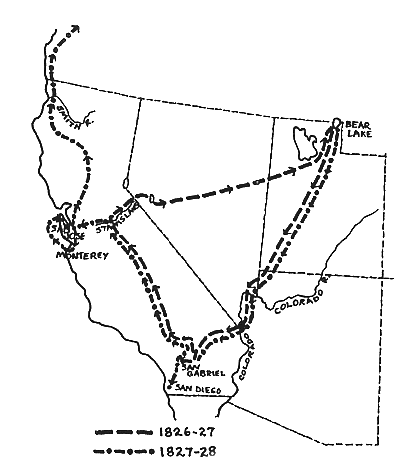| ||||
|
| ||||
|
JEDEDIAH
STRONG SMITH
 Lived:
1799-1831
Lived:
1799-1831
Explored California in: 1826-1828
Exploring for: United States
Explored: by land the length and width of California
When the Spanish were establishing missions in California, Americans were fighting a war for independence on the East Coast. Americans began pushing west, but not until 1826 did they do any serious exploring in California.
EARLY HISTORY
Jedediah Strong Smith was born in New York State, where his parents ran a trading post. When Jedediah was 12 years old, the family moved to Pennsylvania, and later to Ohio. He received a good education, both in school and in the woods. His favorite books, which he carried with him through all his travels, were the Bible and Lewis and Clark’s journal of their northwest adventures.
BACKGROUND
When Jedediah was 22 he went to St. Louis. There he answered an ad in a newspaper for “enterprising young men” to do trapping and exploring. The ad was placed by the fur trading company of William Ashley and Andrew Henry.
Smith was hired and spent the
next several years trapping beaver and exploring. The
In the winter of 1824, Smith and his group of trappers rediscovered South Pass through the Rocky Mountains. The pass (in Wyoming) had been forgotten for a decade. This was an important discovery, for this pass was then used by thousands of Americans as they moved to Oregon and California.
In 1825, Smith became a partner in Ashley’s fur trapping business. In 1826, Smith and two friends bought the Rocky Mountain Fur Company from his former boss. The new company, named Smith, Jackson and Sublette for its owners, became one of the most successful of all fur trapping companies.
SMITH’S JOURNEY
Smith’s great Southwest Expedition of 1826-28 brought him to California. He started from Bear Lake, Utah, near the Great Salt Lake, with 16 companions. They followed the rivers south across the desert land of Utah and Nevada, to where the Colorado River forms the border of present-day California. After some help from the Indians in the Mohave villages there, Smith headed across the Mohave Desert.
This was the hardest part of the trip, in spite of the fact that they followed Indian trails and had two Mohave guides. It was near the end of November when the party finally left the desert. They crossed the San Bernardino Mountains at a place near present-day Cajon Pass, and went down into the green of the Los Angeles basin.
At Mission San Gabriel they were welcomed by Father José Sanchez. They stayed at the mission for several months. The Mexican governor, José María Echeandía, became suspicious of Smith. He ordered him to report to San Diego, then told him to leave California immediately.
Smith, however, had other plans. He wanted to explore California. He and his men went back across the San Bernardino Mountains, but then headed north into the great Central Valley, the first Americans to see this valley. They made their way as far north as the American River near present-day Sacramento, trapping beaver and charting the rivers and mountains.
Now Smith left most of his men and all their beaver furs at a camp on the San Joaquin River. Smith and two partners searched for a way through the Sierra Nevada back to Utah. Following the Stanislaus River, they found a pass (now Ebbets Pass) near Lake Tahoe. The trip back took six weeks, some of it through deep snow, some through burning desert sand. It was July 1827 when they reached Utah.
Having blazed the trail across the Sierra Nevada, Smith now returned to California by the southern route that he had used in 1826. With him were 18 trappers, but ten of them (and all their horses) were killed by Indians before the group reached California.
When Smith got back to the camp where he had left his first group and the furs, he was seized by Mexican officials. Governor Echeandía held Smith in jail in Monterey for over a month. Then he again ordered Smith to leave California.
Smith and his men sold all their furs to an American trading ship in San Francisco. They bought horses and left the San Francisco area in November 1827, driving a herd of 300 horses and mules north. Now Smith trapped and explored along the Sacramento and Trinity rivers. Eventually he reached the Oregon coast.
WHAT HE ACCOMPLISHED
Jedediah Smith opened the way to California for Americans. He was the first white man to cross the Sierra Nevada mountains, and the first American to explore in California. No other individual had seen so much of California.
What he found was shared with other Americans through his letters and journals. Now more accurate maps could be made.
LATER YEARS
Smith retired from trapping in 1830. He sold his business, and decided to be a supplier for wagon trains heading west on the Santa Fe Trail. He thought this would be less dangerous work. On May 27, 1831, Smith was scouting for water along that trail when he was killed in an exchange of gunfire with a small group of Comanche. He was 32 years old.
Smith River in northwestern California is named for the explorer, as is Jedediah Smith State Park in the California redwoods.